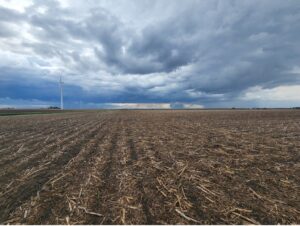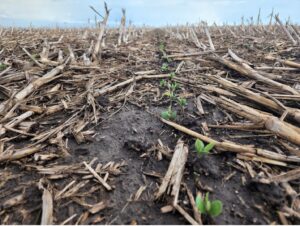Illinois Crops Update 5/27/2022
Each week, I put out a request to crops educators and specialists from the University of Illinois to compile an update to share with the entire state. We hope you find this information useful. If you have any questions or suggestions about the format or any feedback in general about these updates, please email me (harbach2@illinois.edu).
Nick Seiter, field crops entomology Extension specialist, University of Illinois
There have been relatively few early-season insect problems reported so far. Alfalfa weevil activity is higher than normal in many areas. I’ve received reports of large armyworm larvae in southern Illinois, but not at economically damaging levels to this point; farmers in southern and central Illinois should be scouting wheat over the next couple of weeks, as well as corn planted into grass weeds or following a grass cover crop. We are likely a little over a week away from the projected 50% corn rootworm egg hatch in central Illinois, which would be pretty close to an “average” year; (see https://go.illinois.edu/degreedays for specific degree day accumulations in your area).
Aaron Hager, field crops weeds Extension specialist, University of Illinois
A potential scenario of planting delays will be corn planted in fields where no soil-residual herbicide was applied. If the corn has not yet emerged, the soil-residual herbicide can be applied as originally planned. But, what if the corn has emerged and the soil-residual herbicide has not been applied? Can the application proceed as planned, or will a different product need to be selected? The answer depends on the respective herbicide.
Most, but not all, soil residual herbicides can be applied after corn has emerged. Products such as Fierce, Prequel, Sharpen and Verdict must be applied before corn begins to emerge; applications of these products to emerged corn can result in significant corn injury. Be cautious about applying a soil-residual herbicide in UAN carrier if corn has emerged as this can increase the potential for corn injury.
Dennis Bowman, digital agriculture Extension specialist, University of Illinois
I am tracking fields in Macoupin, Macon, and Champaign. Rainfall for the last 7 days was 2.6″, 1.9″, and 1″ respectively. Individual rain events were sometimes spotty. Some limited fieldwork was accomplished in areas. A Thursday afternoon survey of 72 fields in northwest Macon County yielded this information; 34 corn fields emerged ranging from V1- V4, 32 soybean fields emerged many in the unifoliate stage but many others just cracking the surface, 3 fields planted but no crop visible, 3 unplanted fields. Occasional fields showing heavy weed emergence.




Talon Becker, commercial agriculture Extension educator, south-central IL
Minimal fieldwork was completed in the past week in southcentral Illinois, but several fields of corn planted the previous week are emerged and looking good so far. Frequent storms late last week and again for the latter half of this week, as well as cooler weather, have kept soils too wet for tractor traffic in most areas, although some parts of southeastern Illinois have experienced slightly lower rain totals and may have seen more activity. The recent storms have been more scattered, resulting in variable soil moisture conditions across the region. A relatively dry and much warmer forecast through the weekend and several days beyond provides hope that fieldwork will be able to resume by early next week in most areas of the southcentral region.
Nathan Johanning, commercial agriculture Extension educator, southwestern IL
We have been in a cool, wet weather pattern. Our area had received 2-4″ of rain over the past weekend and mid-week have encountered scattered showers. So far this week, most areas have only gotten a few tenths of rain, but with lots of cloudy and overcast skies. Fieldwork and planting have made good progress but now are mainly on hold until soil conditions dry out.
Chelsea Harbach, commercial agriculture Extension educator, northwestern IL
According to the USDA NASS crop progress report, planting progress in Illinois is right on track for the ten-year average with 78% of planting completed with the week ending on May 22. Driving around western Illinois, it does appear that most fields are planted. The corn was quick to pop up with the weather we had a couple of weeks ago. Soybeans are emerging, some with unifoliates completely expanded. The weather in my part of the state has been relatively cool and wet the past week. While I’ve seen some planters going earlier in the week, the rain on Wednesday and Thursday has halted movement. I won’t expect to see much activity until the fields dry up, as we approach the time for post-planting herbicide applications, which will be vital as I’ve seen plenty of fields with some pretty big weeds already. Keep in mind that herbicides are not as effective on larger weeds. These pests will need to be monitored and possibly rogued if post-plant herbicides are rendered ineffective.
The ten-year average growing degree day accumulation from 5/20 to 5/26 for Warren County is 83, and for that same time period this year, we accumulated 113 GDD, despite some cooler days.
Phillip Alberti, commercial agriculture Extension educator, northern IL
After a long-delayed start, planting operations picked up a furious pace over the last few weeks with most of the corn and soybeans planted. The additional rains early in this week were welcome to encourage germination and uniform emergence of the late-planted crops. Spotty conditions led to some uneven planting in some areas while others were able to keep planters rolling consistently. A string of dry weather is expected through the holiday weekend and should allow additional progress to be made.





